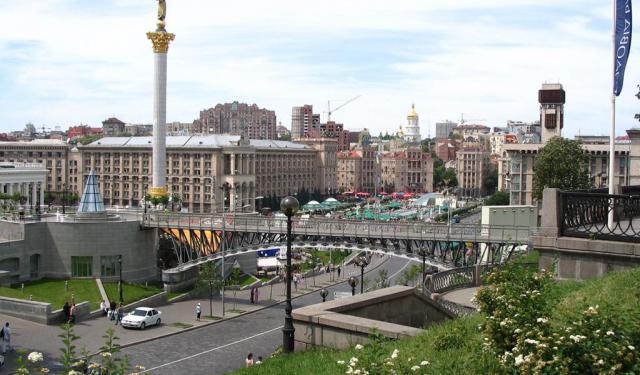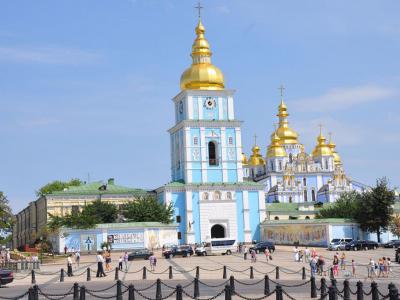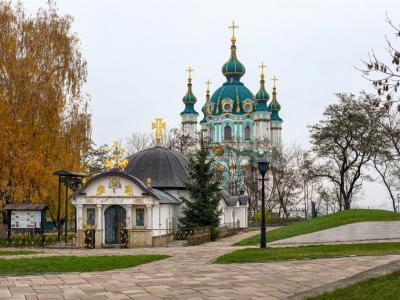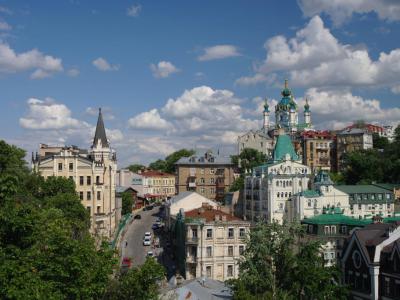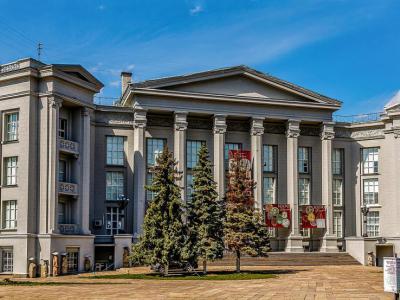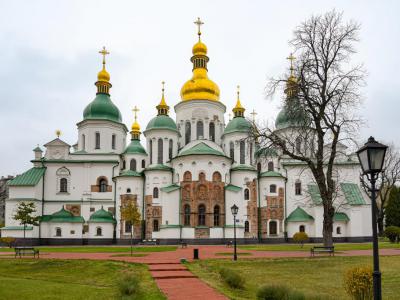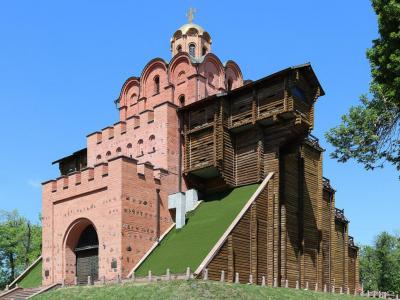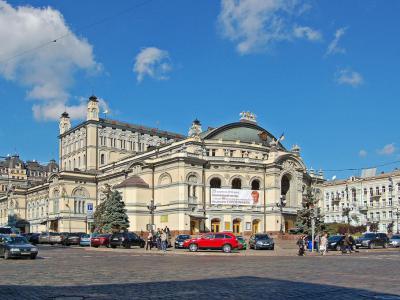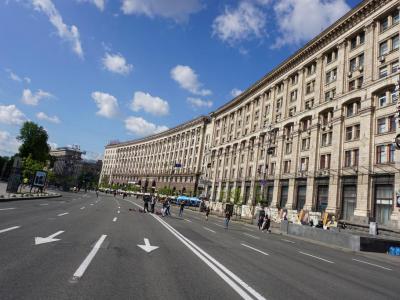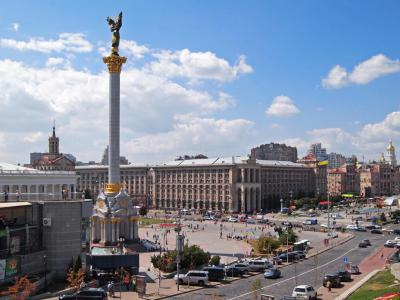Kiev Introduction Walking Tour (Self Guided), Kiev
Kiev is a very old city. It was initiated approximately 1500 years ago. Since 1934, it was Soviet Ukraine's capital and remained the main city of the country with the collapse of the Soviet Union. Being one of the biggest cities in Europe, it has a very specific history, architecture and cultural life. One can never be bored in Kiev, as it has endless interesting and captivating places to see.
How it works: Download the app "GPSmyCity: Walks in 1K+ Cities" from Apple App Store or Google Play Store to your mobile phone or tablet. The app turns your mobile device into a personal tour guide and its built-in GPS navigation functions guide you from one tour stop to next. The app works offline, so no data plan is needed when traveling abroad.
Kiev Introduction Walking Tour Map
Guide Name: Kiev Introduction Walking Tour
Guide Location: Ukraine » Kiev (See other walking tours in Kiev)
Guide Type: Self-guided Walking Tour (Sightseeing)
# of Attractions: 10
Tour Duration: 2 Hour(s)
Travel Distance: 3.6 Km or 2.2 Miles
Author: Cathy
Sight(s) Featured in This Guide:
Guide Location: Ukraine » Kiev (See other walking tours in Kiev)
Guide Type: Self-guided Walking Tour (Sightseeing)
# of Attractions: 10
Tour Duration: 2 Hour(s)
Travel Distance: 3.6 Km or 2.2 Miles
Author: Cathy
Sight(s) Featured in This Guide:
- Saint Michael's Golden-Domed Cathedral and Monastery
- Saint Andrew's Church
- Andreevsky Descent
- The National Museum of Ukrainian History
- Bohdan Khmelnytsky Monument
- Saint Sophia's Cathedral
- Golden Gate
- Opera House
- Khreshchatyk Street
- Maidan Nezalezhnosti (Independence Square)
1) Saint Michael's Golden-Domed Cathedral and Monastery (must see)
Saint Michael’s Golden-Domed Cathedral and Monastery is one of the capital's most striking and symbolically powerful landmarks, embodying the resilience of both the city and its faith. Founded in the 12th century by Prince Sviatopolk II Iziaslavych, the cathedral was dedicated to Saint Michael the Archangel, the celestial protector of Kyiv. In medieval times, its shimmering golden domes—among the first in Kyivan Rus’—and richly painted frescoes made it a masterpiece of Eastern Orthodox architecture, drawing pilgrims and travelers from across the region.
Standing on a bluff overlooking the Dnipro River, the cathedral once formed part of a thriving monastic complex, serving as both a place of worship and a center of learning. Its mosaics and frescoes, crafted by Byzantine and local artists, reflected a fusion of artistic traditions that shaped early Ukrainian religious art.
Tragically, in the 1930s, during the height of Soviet anti-religious campaigns, the cathedral was demolished, and its sacred grounds were turned into a sports and administrative area. Some priceless mosaics and fresco fragments were salvaged and sent to museums in Moscow and Saint Petersburg, though many were lost forever.
In the years following Ukraine’s independence, Saint Michael’s became a powerful symbol of national and spiritual revival. Reconstruction began in 1997, guided by historical records, photographs, and artistic reconstructions. By 2000, the golden domes once again crowned the Kyiv skyline, restored to their original Byzantine brilliance.
Inside, visitors find a dazzling iconostasis, hand-painted murals, and mosaics that reflect both ancient techniques and modern craftsmanship. The monastery complex around the cathedral remains active, housing clergy and supporting community and charitable initiatives. Since December 2018, it has also served as the headquarters of the Orthodox Church of Ukraine.
Standing on a bluff overlooking the Dnipro River, the cathedral once formed part of a thriving monastic complex, serving as both a place of worship and a center of learning. Its mosaics and frescoes, crafted by Byzantine and local artists, reflected a fusion of artistic traditions that shaped early Ukrainian religious art.
Tragically, in the 1930s, during the height of Soviet anti-religious campaigns, the cathedral was demolished, and its sacred grounds were turned into a sports and administrative area. Some priceless mosaics and fresco fragments were salvaged and sent to museums in Moscow and Saint Petersburg, though many were lost forever.
In the years following Ukraine’s independence, Saint Michael’s became a powerful symbol of national and spiritual revival. Reconstruction began in 1997, guided by historical records, photographs, and artistic reconstructions. By 2000, the golden domes once again crowned the Kyiv skyline, restored to their original Byzantine brilliance.
Inside, visitors find a dazzling iconostasis, hand-painted murals, and mosaics that reflect both ancient techniques and modern craftsmanship. The monastery complex around the cathedral remains active, housing clergy and supporting community and charitable initiatives. Since December 2018, it has also served as the headquarters of the Orthodox Church of Ukraine.
2) Saint Andrew's Church
Saint Andrew's Church is a Baroque-style church perched on a hill overlooking the historic Podil and Dnipro River areas of Kyiv. Designed by Italian architect Bartolomeo Rastrelli, it was constructed between 1747 and 1754 to mark the site where Saint Andrew is said to have erected a cross and foretold the founding of a Christian city.
The church is notable for its green-and-white façade, golden domes, and intricate Baroque details.
Over the years, the church has served multiple purposes. While it operated as a museum for many decades, it has also hosted religious services. In 2018, it was gifted to the Ecumenical Patriarchate of Constantinople, reinforcing its role as a living religious site.
A unique aspect of the church is that it has no bells, following a local legend that ringing them would destabilize the hill and flood the city.
The church underwent a major, multi-year restoration, completed in December 2020, preserving its architectural and artistic features while ensuring it could safely accommodate both visitors and worshippers. The interior showcases frescoes, decorative moldings, and an iconostasis, highlighting the craftsmanship of the late 18th century.
The church is notable for its green-and-white façade, golden domes, and intricate Baroque details.
Over the years, the church has served multiple purposes. While it operated as a museum for many decades, it has also hosted religious services. In 2018, it was gifted to the Ecumenical Patriarchate of Constantinople, reinforcing its role as a living religious site.
A unique aspect of the church is that it has no bells, following a local legend that ringing them would destabilize the hill and flood the city.
The church underwent a major, multi-year restoration, completed in December 2020, preserving its architectural and artistic features while ensuring it could safely accommodate both visitors and worshippers. The interior showcases frescoes, decorative moldings, and an iconostasis, highlighting the craftsmanship of the late 18th century.
3) Andreevsky Descent (must see)
Andreevsky Descent is one of the city's oldest and most atmospheric streets, winding steeply from the Upper Town down to the historic Podil district below. Its origins date back to the Kyivan Rus’ era, when it served as one of the main routes connecting the political and religious center of the city on the hill with the bustling trade quarter along the Dnipro River.
Centuries later, during the 19th century, the descent took on even greater significance as Kyiv expanded, becoming a lively thoroughfare linking key neighborhoods and a gathering place for merchants, travelers, and residents alike.
Paved with uneven cobblestones and lined with an eclectic mix of buildings, Andreevsky Descent feels like a walk through time. Its architecture reflects the evolution of the city—from 18th- and 19th-century townhouses adorned with ornate facades to later structures influenced by early 20th-century European styles.
Many of these buildings once belonged to merchants and craftsmen, their ground floors serving as workshops or small trading spaces, giving the street its enduring sense of creativity and enterprise.
Over the years, the descent has developed into the artistic and cultural heart of the capital. Its narrow passageways are now filled with art galleries, cozy cafes, artisan shops, and small museums, each with its own character and charm. The sound of street musicians often echoes off the walls, mingling with the voices of locals and travelers who come to explore its vibrant scene. On weekends, the cobblestones come alive with stalls selling paintings, handcrafted jewelry, ceramics, and traditional Ukrainian embroidery.
Centuries later, during the 19th century, the descent took on even greater significance as Kyiv expanded, becoming a lively thoroughfare linking key neighborhoods and a gathering place for merchants, travelers, and residents alike.
Paved with uneven cobblestones and lined with an eclectic mix of buildings, Andreevsky Descent feels like a walk through time. Its architecture reflects the evolution of the city—from 18th- and 19th-century townhouses adorned with ornate facades to later structures influenced by early 20th-century European styles.
Many of these buildings once belonged to merchants and craftsmen, their ground floors serving as workshops or small trading spaces, giving the street its enduring sense of creativity and enterprise.
Over the years, the descent has developed into the artistic and cultural heart of the capital. Its narrow passageways are now filled with art galleries, cozy cafes, artisan shops, and small museums, each with its own character and charm. The sound of street musicians often echoes off the walls, mingling with the voices of locals and travelers who come to explore its vibrant scene. On weekends, the cobblestones come alive with stalls selling paintings, handcrafted jewelry, ceramics, and traditional Ukrainian embroidery.
4) The National Museum of Ukrainian History
The National Museum of the History of Ukraine offers a comprehensive overview of the country’s past, from prehistoric times to the modern era. Founded in 1904, the museum began with private archaeological collections and gained government support in 1909. Its exhibits were moved to the Kyiv-Pechersk Lavra in 1935 and evacuated to Ufa during World War II, before returning to Kyiv in 1944, where it remains today on Starokyivska Hill.
Covering over 9,000 years of history, the museum traces Ukraine’s story from the Trypillya settlements (circa 7000 B.C.), through the Greek and Scythian periods, the rise of Kyivan Rus, the Cossack era, and the Soviet period, up to Ukraine’s recent independence. Modern exhibits explore the country’s political and cultural transformation, including displays on the Orange Revolution and contemporary national movements.
With more than 800,000 artifacts, the museum’s collections include rare coins, weaponry, manuscripts, folk costumes, and archaeological treasures. Highlights feature fine glass and porcelain, ethnographic items, and personal belongings of notable figures such as Serge Lifar, the celebrated Ukrainian ballet dancer known as “the god of dance.”
Renamed the National Museum of the History of Ukraine after independence in 1991, the institution adopted the name “MIST” in 2020—meaning “bridge” in Ukrainian—to reflect its mission of linking the nation’s past and future. Recognized as one of Kyiv’s leading cultural landmarks, the museum provides visitors with a deep understanding of Ukraine’s historical resilience and cultural heritage.
Covering over 9,000 years of history, the museum traces Ukraine’s story from the Trypillya settlements (circa 7000 B.C.), through the Greek and Scythian periods, the rise of Kyivan Rus, the Cossack era, and the Soviet period, up to Ukraine’s recent independence. Modern exhibits explore the country’s political and cultural transformation, including displays on the Orange Revolution and contemporary national movements.
With more than 800,000 artifacts, the museum’s collections include rare coins, weaponry, manuscripts, folk costumes, and archaeological treasures. Highlights feature fine glass and porcelain, ethnographic items, and personal belongings of notable figures such as Serge Lifar, the celebrated Ukrainian ballet dancer known as “the god of dance.”
Renamed the National Museum of the History of Ukraine after independence in 1991, the institution adopted the name “MIST” in 2020—meaning “bridge” in Ukrainian—to reflect its mission of linking the nation’s past and future. Recognized as one of Kyiv’s leading cultural landmarks, the museum provides visitors with a deep understanding of Ukraine’s historical resilience and cultural heritage.
5) Bohdan Khmelnytsky Monument
The Bohdan Khmelnytsky Monument stands in the center of Sofiivska Square and is one of the most recognized landmarks commemorating Ukraine’s history.
Erected in 1888, the monument honors Bohdan Khmelnytsky, the 17th-century Hetman of the Zaporizhian Host, who led a major uprising against Polish rule and played a crucial role in shaping early Ukrainian statehood. The equestrian statue was designed by sculptor Mikhail Mikeshin and funded through public donations, reflecting Khmelnytsky’s enduring place in national memory.
The monument depicts Khmelnytsky on horseback, raising his mace as if leading troops into battle. The dynamic pose symbolizes leadership, strength, and the struggle for independence.
Originally, the design included more elaborate details and figures, but due to financial and political limitations, it was simplified to focus solely on the figure of Khmelnytsky and his horse. This simplicity gives the monument a strong and clear visual message that has stood the test of time.
Over the years, the Bohdan Khmelnytsky Monument has served as a gathering point for public events, national celebrations, and historical commemorations. It occupies a prominent position near Saint Sophia’s Cathedral, creating a meaningful connection between the nation’s religious and political heritage. The monument has undergone restoration several times to preserve its structure and details, maintaining its significance as a symbol of Ukrainian identity.
Erected in 1888, the monument honors Bohdan Khmelnytsky, the 17th-century Hetman of the Zaporizhian Host, who led a major uprising against Polish rule and played a crucial role in shaping early Ukrainian statehood. The equestrian statue was designed by sculptor Mikhail Mikeshin and funded through public donations, reflecting Khmelnytsky’s enduring place in national memory.
The monument depicts Khmelnytsky on horseback, raising his mace as if leading troops into battle. The dynamic pose symbolizes leadership, strength, and the struggle for independence.
Originally, the design included more elaborate details and figures, but due to financial and political limitations, it was simplified to focus solely on the figure of Khmelnytsky and his horse. This simplicity gives the monument a strong and clear visual message that has stood the test of time.
Over the years, the Bohdan Khmelnytsky Monument has served as a gathering point for public events, national celebrations, and historical commemorations. It occupies a prominent position near Saint Sophia’s Cathedral, creating a meaningful connection between the nation’s religious and political heritage. The monument has undergone restoration several times to preserve its structure and details, maintaining its significance as a symbol of Ukrainian identity.
6) Saint Sophia's Cathedral (must see)
Saint Sophia’s Cathedral stands at the heart of the city's as one of the most magnificent testaments to the city’s medieval heritage and the spiritual power of Kyivan Rus’. Commissioned in the 11th century by Prince Yaroslav the Wise, the cathedral was conceived not only as a house of worship but also as a statement of cultural and political strength, marking Kyiv as a major center of Christianity in Eastern Europe. Named after the Hagia Sophia in Constantinople, it reflected the influence of Byzantine architecture while incorporating distinctly local artistic traditions.
The cathedral’s design follows the cross-in-square plan typical of Byzantine churches, crowned by multiple domes that once shimmered above the city’s skyline.
Inside, visitors are greeted by an astonishing array of mosaics and frescoes—over 3,000 square meters of them—depicting saints, angels, and biblical scenes in luminous gold, emerald, and cobalt tones. Among its most celebrated works is the Praying Virgin, a grand mosaic figure that dominates the apse, symbolizing divine protection over Kyiv.
As centuries passed, restorations and expansions transformed the cathedral’s silhouette. During the 17th and 18th centuries, under the influence of the Cossack Hetmanate, the structure was embellished with graceful Ukrainian Baroque elements—whitewashed walls, gilded domes, and ornate bell towers that softened the strict lines of its Byzantine core. Despite wars, fires, and the neglect of certain eras, a remarkable portion of the 11th-century frescoes and mosaics has survived, offering a rare glimpse into early medieval art.
The cathedral complex today encompasses bell towers, monastic quarters, and defensive walls, all enclosed within a peaceful courtyard that contrasts sharply with the city’s modern bustle outside. As a UNESCO World Heritage Site, Saint Sophia’s remains a destination where travelers can walk through nearly a thousand years of history, surrounded by the enduring colors, shapes, and symbols that once defined the spiritual life of Kyivan Rus’.
The cathedral’s design follows the cross-in-square plan typical of Byzantine churches, crowned by multiple domes that once shimmered above the city’s skyline.
Inside, visitors are greeted by an astonishing array of mosaics and frescoes—over 3,000 square meters of them—depicting saints, angels, and biblical scenes in luminous gold, emerald, and cobalt tones. Among its most celebrated works is the Praying Virgin, a grand mosaic figure that dominates the apse, symbolizing divine protection over Kyiv.
As centuries passed, restorations and expansions transformed the cathedral’s silhouette. During the 17th and 18th centuries, under the influence of the Cossack Hetmanate, the structure was embellished with graceful Ukrainian Baroque elements—whitewashed walls, gilded domes, and ornate bell towers that softened the strict lines of its Byzantine core. Despite wars, fires, and the neglect of certain eras, a remarkable portion of the 11th-century frescoes and mosaics has survived, offering a rare glimpse into early medieval art.
The cathedral complex today encompasses bell towers, monastic quarters, and defensive walls, all enclosed within a peaceful courtyard that contrasts sharply with the city’s modern bustle outside. As a UNESCO World Heritage Site, Saint Sophia’s remains a destination where travelers can walk through nearly a thousand years of history, surrounded by the enduring colors, shapes, and symbols that once defined the spiritual life of Kyivan Rus’.
7) Golden Gate
The Golden Gate is one of the most significant historical monuments in the city, dating back to the early 11th century. It was constructed around 1037 during the reign of Yaroslav the Wise as part of the city’s defensive fortifications. Serving as the main southern entrance to the medieval city, the gate symbolized both military strength and the growing importance of Kyiv as the capital of Kyivan Rus.
Its name is believed to have been inspired by the Golden Gate of Constantinople, reflecting the cultural and political connections between the two centers.
Originally, the structure combined a fortified gateway with a church built above it, known as the Church of the Annunciation. This dual purpose—defensive and religious—was common in early medieval fortifications.
Over the centuries, however, the gate suffered damage from invasions, natural decay, and urban expansion. By the 18th century, only ruins remained, though they continued to serve as a powerful reminder of the city’s medieval past.
In the 1980s, extensive restoration work was carried out to reconstruct the Golden Gate based on archaeological findings and historical descriptions. The modern structure includes a museum inside, where visitors can learn about the history of the original fortifications and view artifacts uncovered during excavations. The reconstructed wooden superstructure gives an impression of how the gate might have appeared nearly a thousand years ago.
Its name is believed to have been inspired by the Golden Gate of Constantinople, reflecting the cultural and political connections between the two centers.
Originally, the structure combined a fortified gateway with a church built above it, known as the Church of the Annunciation. This dual purpose—defensive and religious—was common in early medieval fortifications.
Over the centuries, however, the gate suffered damage from invasions, natural decay, and urban expansion. By the 18th century, only ruins remained, though they continued to serve as a powerful reminder of the city’s medieval past.
In the 1980s, extensive restoration work was carried out to reconstruct the Golden Gate based on archaeological findings and historical descriptions. The modern structure includes a museum inside, where visitors can learn about the history of the original fortifications and view artifacts uncovered during excavations. The reconstructed wooden superstructure gives an impression of how the gate might have appeared nearly a thousand years ago.
8) Opera House (must see)
The Kyiv Opera House, formally known as the Taras Shevchenko National Opera and Ballet Theatre of Ukraine, stands as one of the city's most iconic cultural landmarks and a testament to the city’s artistic heritage. Founded in 1867, the opera company predates the current building, which was completed in 1901 after a devastating fire destroyed the earlier theater. Since then, the grand structure on Volodymyrska Street has become a defining part of Kyiv’s cultural and architectural landscape.
Its architect, Viktor Schröter, designed the building in the eclectic style popular in late 19th-century Europe, blending Neo-Renaissance and Neo-Baroque elements. The result is a façade adorned with elegant arches, intricate reliefs, and symbolic ornamentation. Inside, visitors are met with a lavish interior featuring marble staircases, gilded balconies, and a magnificent chandelier that bathes the hall in warm light.
The theater’s acoustics are world-renowned, carefully engineered to ensure that every note, whether sung by a soloist or played by the orchestra, reaches the audience with perfect clarity.
Throughout its history, the Kyiv Opera House has hosted an impressive range of performances and artists—from timeless operas like Carmen and La Traviata to contemporary ballets and original Ukrainian works. The stage has welcomed world-famous performers and nurtured generations of Ukrainian talent, becoming a cornerstone of the country’s performing arts.
The theater has also undergone several renovations, most notably in the 1980s, when the stage and orchestra pit were expanded to accommodate up to 100 musicians. Care was taken to preserve the opulent décor—murals, stucco details, and crystal chandeliers—while upgrading the technical infrastructure for modern productions. Today, audiences still gather beneath the soaring dome of the main auditorium, where history, culture, and artistry converge in every performance.
Its architect, Viktor Schröter, designed the building in the eclectic style popular in late 19th-century Europe, blending Neo-Renaissance and Neo-Baroque elements. The result is a façade adorned with elegant arches, intricate reliefs, and symbolic ornamentation. Inside, visitors are met with a lavish interior featuring marble staircases, gilded balconies, and a magnificent chandelier that bathes the hall in warm light.
The theater’s acoustics are world-renowned, carefully engineered to ensure that every note, whether sung by a soloist or played by the orchestra, reaches the audience with perfect clarity.
Throughout its history, the Kyiv Opera House has hosted an impressive range of performances and artists—from timeless operas like Carmen and La Traviata to contemporary ballets and original Ukrainian works. The stage has welcomed world-famous performers and nurtured generations of Ukrainian talent, becoming a cornerstone of the country’s performing arts.
The theater has also undergone several renovations, most notably in the 1980s, when the stage and orchestra pit were expanded to accommodate up to 100 musicians. Care was taken to preserve the opulent décor—murals, stucco details, and crystal chandeliers—while upgrading the technical infrastructure for modern productions. Today, audiences still gather beneath the soaring dome of the main auditorium, where history, culture, and artistry converge in every performance.
9) Khreshchatyk Street (must see)
Khreshchatyk Street is the vibrant and historic main boulevard of Kyiv, stretching just over a kilometer between European Square and Bessarabska Square, with the iconic Independence Square at its center.
Though relatively short, it has long served as the commercial, cultural, and social heart of the city, its sidewalks and façades reflecting over two centuries of Kyiv’s evolution. The street is lined with government buildings, elegant shops, cafés, and cultural landmarks, each bearing witness to different eras in the city’s development, from imperial ambitions to Soviet reconstruction, and now, contemporary Ukrainian life.
Khreshchatyk’s history is both dramatic and poignant. During World War II, the street was almost entirely destroyed—not by aerial bombardment, but through deliberate demolition. As the Soviet army retreated from Kyiv in 1941, they planted radio-controlled explosives throughout the buildings, making Khreshchatyk one of the earliest documented examples of such a tactic in military history.
This act of destruction left the city center in ruins, symbolizing both the intensity of the war and the strategic ruthlessness of the scorched-earth policy employed by the Soviets.
Following the war, Khreshchatyk was rebuilt between the late 1940s and early 1950s in the monumental Stalinist style, giving the street its distinctive uniform façades, wide sidewalks, and grand, imposing appearance. The reconstructed boulevard reflected Soviet ideals of grandeur and civic pride, while also integrating modern infrastructure to accommodate the city’s growth. The architectural style, characterized by symmetry, massive columns, and decorative detailing, remains one of the street’s most striking features, providing visitors with a vivid sense of Kyiv’s post-war transformation.
In contemporary times, Khreshchatyk takes on a more leisurely rhythm. Since the late 1990s, the street has been closed to traffic on weekends, turning it into a bustling pedestrian zone where locals and visitors stroll freely, enjoy street performances, or relax in the cafés that line the boulevard.
Though relatively short, it has long served as the commercial, cultural, and social heart of the city, its sidewalks and façades reflecting over two centuries of Kyiv’s evolution. The street is lined with government buildings, elegant shops, cafés, and cultural landmarks, each bearing witness to different eras in the city’s development, from imperial ambitions to Soviet reconstruction, and now, contemporary Ukrainian life.
Khreshchatyk’s history is both dramatic and poignant. During World War II, the street was almost entirely destroyed—not by aerial bombardment, but through deliberate demolition. As the Soviet army retreated from Kyiv in 1941, they planted radio-controlled explosives throughout the buildings, making Khreshchatyk one of the earliest documented examples of such a tactic in military history.
This act of destruction left the city center in ruins, symbolizing both the intensity of the war and the strategic ruthlessness of the scorched-earth policy employed by the Soviets.
Following the war, Khreshchatyk was rebuilt between the late 1940s and early 1950s in the monumental Stalinist style, giving the street its distinctive uniform façades, wide sidewalks, and grand, imposing appearance. The reconstructed boulevard reflected Soviet ideals of grandeur and civic pride, while also integrating modern infrastructure to accommodate the city’s growth. The architectural style, characterized by symmetry, massive columns, and decorative detailing, remains one of the street’s most striking features, providing visitors with a vivid sense of Kyiv’s post-war transformation.
In contemporary times, Khreshchatyk takes on a more leisurely rhythm. Since the late 1990s, the street has been closed to traffic on weekends, turning it into a bustling pedestrian zone where locals and visitors stroll freely, enjoy street performances, or relax in the cafés that line the boulevard.
10) Maidan Nezalezhnosti (Independence Square) (must see)
Maidan Nezalezhnosti, or Independence Square, sits at the very heart of the capital, forming the vibrant center of both civic life and the city’s cultural memory. Stretching along Khreshchatyk Street, it is one of Ukraine’s most recognizable public spaces, a place where locals and visitors alike come together to walk, meet, and experience the pulse of the capital.
The square’s history, however, extends far beyond its modern identity, evolving from a low-lying area on the city’s outskirts into the monumental and symbolic hub it is today.
The name “Maidan Nezalezhnosti” was officially adopted following Ukraine’s independence in 1991, reflecting the country’s new sovereignty and the square’s role as a national symbol. Over the decades, it became a stage for civic and political life, hosting everything from parades and public celebrations to pivotal moments of protest and revolution.
Most notably, it gained worldwide attention during the Orange Revolution of 2004, when citizens rallied peacefully to demand democratic reforms, and the Revolution of Dignity (also called Euromaidan) in 2013–2014, which saw massive gatherings calling for government accountability, civil rights, and alignment with European values. These events deeply shaped the square’s identity, turning it into a place of remembrance, resilience, and national pride.
Architecturally and culturally, the square is framed by fountains, sculptures, and the Independence Monument, a tall column crowned with the figure of Berehynia, a traditional guardian spirit in Ukrainian folklore. Surrounding the square are historic government buildings, shopping arcades, and cultural landmarks, which together create a sense of continuity between past and present. Since 2014, large-scale entertainment events and fairs have been moved to nearby locations, such as Sofiyivska Square, in recognition of Maidan’s significance as a memorial site.
The square’s history, however, extends far beyond its modern identity, evolving from a low-lying area on the city’s outskirts into the monumental and symbolic hub it is today.
The name “Maidan Nezalezhnosti” was officially adopted following Ukraine’s independence in 1991, reflecting the country’s new sovereignty and the square’s role as a national symbol. Over the decades, it became a stage for civic and political life, hosting everything from parades and public celebrations to pivotal moments of protest and revolution.
Most notably, it gained worldwide attention during the Orange Revolution of 2004, when citizens rallied peacefully to demand democratic reforms, and the Revolution of Dignity (also called Euromaidan) in 2013–2014, which saw massive gatherings calling for government accountability, civil rights, and alignment with European values. These events deeply shaped the square’s identity, turning it into a place of remembrance, resilience, and national pride.
Architecturally and culturally, the square is framed by fountains, sculptures, and the Independence Monument, a tall column crowned with the figure of Berehynia, a traditional guardian spirit in Ukrainian folklore. Surrounding the square are historic government buildings, shopping arcades, and cultural landmarks, which together create a sense of continuity between past and present. Since 2014, large-scale entertainment events and fairs have been moved to nearby locations, such as Sofiyivska Square, in recognition of Maidan’s significance as a memorial site.
Walking Tours in Kiev, Ukraine
Create Your Own Walk in Kiev
Creating your own self-guided walk in Kiev is easy and fun. Choose the city attractions that you want to see and a walk route map will be created just for you. You can even set your hotel as the start point of the walk.
Kiev's Architectural Jewels
Kiev is a city with such a wide diversity of architectural styles from various periods of time. The best European, Russian and Ukrainian architects and artists worked on the buildings of the capital of Ukraine. Some of the elements are absolutely unique and can be seen exclusively in Kiev. Some of the most famed architects who contributed to the city's beauty and originality are Vikentiy... view more
Tour Duration: 2 Hour(s)
Travel Distance: 4.1 Km or 2.5 Miles
Tour Duration: 2 Hour(s)
Travel Distance: 4.1 Km or 2.5 Miles
Andriyivskyy Descent Walk
Andriyivskyy (Andrew's) Descent is a historic cobblestone street, running 720 meters (2,360 ft) downhill from the Upper (Old) Town of Kiev to the once commercial neighborhood of Podil (Lower Town), ending at Kontraktova Square.
According to a legend, there was once a sea where the Dnieper River now flows. When Saint Andrew, the Apostle came to Kiev and erected a cross on the spot where St... view more
Tour Duration: 1 Hour(s)
Travel Distance: 0.6 Km or 0.4 Miles
According to a legend, there was once a sea where the Dnieper River now flows. When Saint Andrew, the Apostle came to Kiev and erected a cross on the spot where St... view more
Tour Duration: 1 Hour(s)
Travel Distance: 0.6 Km or 0.4 Miles
Monastery of Kiev Caves Tour
Some sources say that Kievo-Pecherskaya Lavra (Monastery of Kiev Caves Tour) was initiated in 1051, when Reverend Anthony arrived there. He, together with some of his followers, built an entire complex composed of caves and monasteries. When the monks moved to a monastery which is on Lavra's territory, the caves were utilized as burial sites. Nowadays it is included in the UNESCO World... view more
Tour Duration: 1 Hour(s)
Travel Distance: 1.5 Km or 0.9 Miles
Tour Duration: 1 Hour(s)
Travel Distance: 1.5 Km or 0.9 Miles
Useful Travel Guides for Planning Your Trip
Kiev Souvenirs: 12 Distinctively Ukrainian Products to Bring Home
In recent years, Ukraine has made the news rather distant from welcoming tourism. Still, despite some controversial publicity, the country - for the most part - continues normal life and retains its traditional hospitality. There are quite a few things in Kiev, distinctively Ukrainian, that a...
The Most Popular Cities
/ view all
